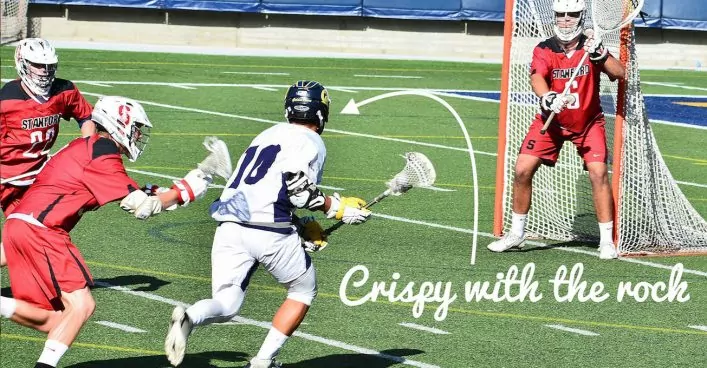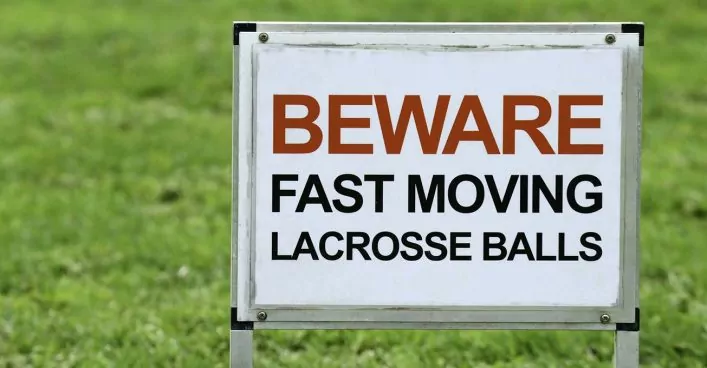The lacrosse goalie is the leader of the defense.
And while goalies will never engage in one-on-one defense the way a long stick defender does, it’s still important to understand the basics of lacrosse defense.
This way you can offer coaching and spot problems with individual defenders given your unique view of the field.
By learning the basics of playing solid one-on-one lacrosse defense a goalie will become a better leader.
This post is a guide to help goalies understand the techniques involved in playing dominating one-on-one defense in the sport of lacrosse.
As a goalie, you know that when a shooter is in the middle of the field he is much more dangerous compared to when he’s driving down the alley on the side of the field.
The former gives the shooter the entire 6′ by 6′ goal to shoot at, while the latter reduces the size of the goal drastically.
Therefore, the first rule of on-ball lacrosse defense is: Force down the allies and don’t get beat topside.
This means as a defender you want to use your body positioning to force the attackman down the alleys.
The way a defender sets up with his body position should encourage offensive players to drive down the alleys.
Given the goalie’s unique view on the field, you’ll be able to tell if the defenders’ angle and positioning is correct.
Sometimes defenders will not be in the correct position to force players down the alleys. It is then the goalie’s responsibility to be vocal and alert the teammate how to correct his or her positioning.
Part of the lacrosse goalie terminology is alerting your teammates to correct their defensive positioning.
SHIFT LEFT or SHIFT RIGHT – Will let defenseman know he needs to move left or right. lacrosse goalie terms
YOU’RE GOOD – Will let defenseman know his positioning is perfect.
Defenders should never play attackman straight up. Their body positioning should always be forcing the ball carrier down the sides of the fields.
Then they should never get beat over the top, or towards the middle of the field.
Body positioning is the single most important element of on-ball defense and its the reason why many defensive coaches often run drills where the D cannot use their sticks.

Once the defender is in solid positioning the next step is to engage the hips.
As the ball carrier approaches, defenders should place their stick on the hip. The head of the defenseman’s stick remains towards the middle of the field so that we don’t get beat topside.
With the stick on the ball carrier’s hip, the defender can ride the player down the alley.

As he or she drives, the defender’s body positioning should lag behind just slightly.
Then in the event that the ball carrier tries to roll back towards the middle, the defender is already in a position to stop this move and encourage the attacker to continue down the alley.
Again, engaging the hips does not rely on the stick and can be taught to defenders without their stick in hand to focus on solid technique without the distraction of the stick.
While good lacrosse defense is primarily about footwork and body positioning, the defender’s job is also to make the ball carrier as uncomfortable as possible.
This is done by throwing checks.
There are lots of different types of checks that defenders can use but I only teach 3 checks – Poke, Slap, Lift.
Understanding lacrosse defense for goalies means knowing what these checks are and when to use them so you can ensure your team is playing great defense.

The poke check is the single greatest type of check a defenseman can throw.
Why?
Because 1.) Attackman hate when your stick is on their gloves or interrupting their cradling or passing motion 2.) When thrown properly a stick check doesn’t put the defender out of position.
To throw a proper poke check simply lunge your bottom hand at the opponent making the head of your stick contact his hands, stick or numbers.
Don’t lunge with your whole body because you’ll be out of position in the event the check doesn’t dislodge the ball. Lunge with your hands while your body remains in solid defensive positioning.
Also be sure not to come out of the proper defensive stance when throwing the poke check. The ability to stay in a great stance is what makes the poke check such a powerful technique.
A perfect opportunity for a poke check is when an attacker brings his stick in front of his/her face for a split dodge.
Youth defenders don’t utilize the poke nearly enough. I often see attackmen just standing behind the goal at X in the perfect feeding position and defenders are not harassing them with poke checks.
As a goalie, yell “POKE” at your defenders to remind them to utilize this awesome check. If the ball carrier is close enough to the defender that he can land a poke check, he absolutely should be doing it.
A slap check is a quick chop landing on the opponent’s hands or stick.
Defenders should not do a full windup when executing a slap check because 1) this is a slash and will often be called a penalty and 2) by pulling the stick all the back you create a lane for the attacker.
The slap check should be short, hard slaps with the objective of dislodging the ball and making the ball carrier uncomfortable.
When a defender pushes his opponent’s hips and creates a little bit of separation this is a perfect opportunity to throw a slap check or two on the bottom hand before reengaging the hips to play solid defense.
Remind your defenseman to throw slap checks by yelling “SLAP”.
Finally, the lift is the final type of check I teach where you lift the hands or stick of ball carrier.
This will prevent the attacker from making an accurate pass or shooting with any kind of power.
As a driving opponent raises his hands to shoot you can remind the D to lift by yelling “LIFT”.
In addition to the poke, slap, and lift there are many other types of lacrosse checks: Wrap Check, Ding Dong, Over-The-Head Check, Back Slap, Butt Dig, Kayak, Scissor, Back Side Wrap check, Pencil check, … the list goes on and on.
But the basics of solid lacrosse defense revolve around 3 checks – poke, slap, and lift.
You can forget about all the other types of checks especially as a beginner.
Your primary job as a goalie is to stop shots. But you must also be a leader on the field.
A leader knows how to direct others and spot problems that can be corrected.
By learning the basics of lacrosse on-ball defense a goalie will become a better leader.
Goalies don’t necessarily need to be great on-ball defenders but they must know the techniques and strategies well enough to spot when a teammate is not executing them properly.
Until next time! Coach Damon
Any other tips for lacrosse defense for goalies? Any questions? Let me know in the comments.








 14 Amazing Lacrosse Goalie DrillsAug. 1, 2024
14 Amazing Lacrosse Goalie DrillsAug. 1, 2024 Quick Guide To Lacrosse Slang TermsApril 14, 2025
Quick Guide To Lacrosse Slang TermsApril 14, 2025 Lacrosse Goalies Rules To KnowJune 28, 2022
Lacrosse Goalies Rules To KnowJune 28, 2022 Lacrosse Goalie Step-by-Step Guide to Getting RecruitedFebruary 6, 2022
Lacrosse Goalie Step-by-Step Guide to Getting RecruitedFebruary 6, 2022 18 Lacrosse Goalie Drills to Improve Your GameApril 24, 2025
18 Lacrosse Goalie Drills to Improve Your GameApril 24, 2025 7 Elements of a Great Lacrosse Goalie StanceAug. 1, 2020
7 Elements of a Great Lacrosse Goalie StanceAug. 1, 2020 12 Lacrosse Goalie Tips To Take Your Game to the Next LevelSeptember 10, 2024
12 Lacrosse Goalie Tips To Take Your Game to the Next LevelSeptember 10, 2024 STX Eclipse 3 Goalie Head ReviewApril 24, 2025
STX Eclipse 3 Goalie Head ReviewApril 24, 2025 Lacrosse Goalie WorkoutAug. 12, 2019
Lacrosse Goalie WorkoutAug. 12, 2019 The Basics of Making a SaveJune 29, 2021
The Basics of Making a SaveJune 29, 2021


















































Hello! Thanks for your info. I am looking for a good guide to break down Lax D to highschool girls who haven’t played before. Preferably a step wise approach to DRILLS advancing from individual 1v. 1 D to team Defense. Any good advice on resources would be appreciated.
I think http://www.laxcoachmike.com/ has some material like that. Let me know if you find something. Good luck.